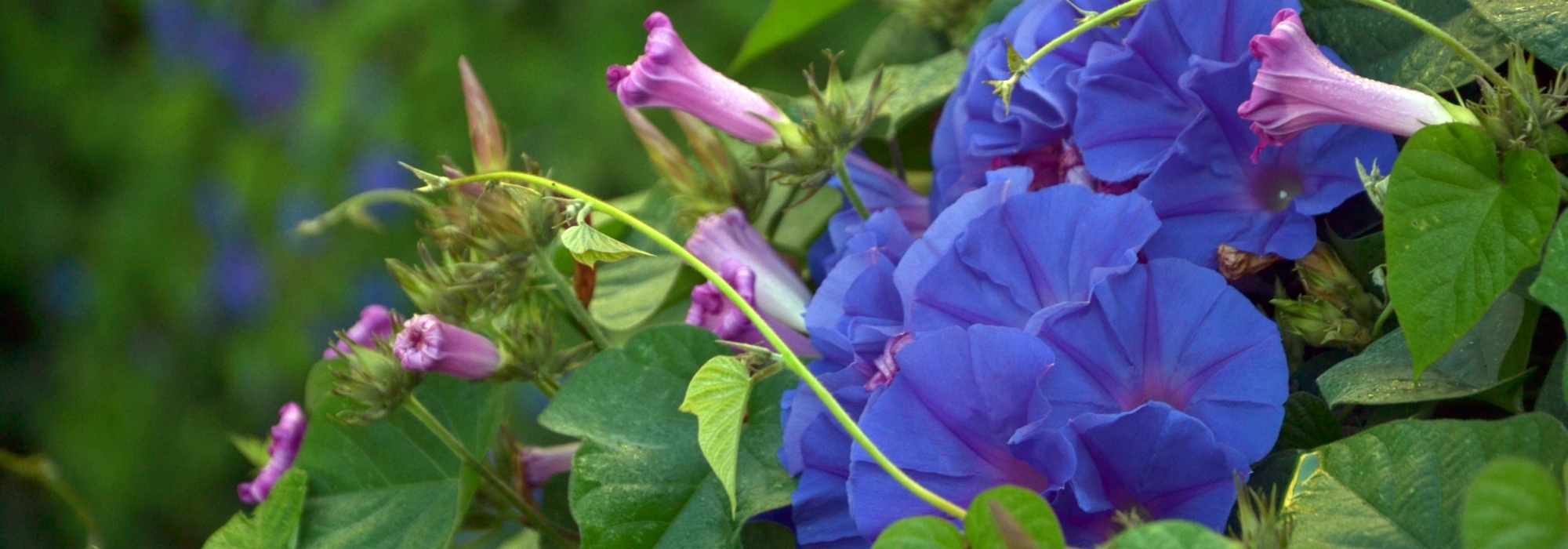
7 climbing plants with rapid growth
for busy gardeners
Contents
While many climbing plants become voluble once established after a few years, such as Wisteria or Trumpet Vine, some climbing plants are very useful as they grow rapidly from the moment of planting. They can quickly conceal an unsightly wall or an ugly fence, for example. The impatient gardener is delighted to rely on climbing plants that make an immediate impact in the first year of growth. Hops, Passionflower, Honeysuckle, as well as Luffa, Ipomoea, Holboellia… remarkable for their foliage or flowering, these fast-growing climbers ensure prolific vegetation, done quickly and effectively.
Discover our selection of 9 climbing plants that grow faster than light!
Hops: charming and bright
Humulus lupulus, commonly known as hop, is a lovely voluble liana from a young age. It grows about 1 m in 1 month from the second month of cultivation and reaches its adult height of 5 to 6 m in a single season! The hop produces unusual flowers in summer, a beautiful yellow-green, sometimes white or mauve depending on the varieties, grouped at the tips of the stems in small pendulous cones, giving this climbing plant a unique charm. Its foliage, although deciduous, provides this liana with a major ornamental asset, featuring large lobed leaves reminiscent of vine foliage, ensuring a stunning covering effect. Some varieties have larger flowers, such as the variety ‘Magnum’, while others display variegated foliage with white, and others a beautiful golden green like Humulus lupulus ‘Aureus’, the latter being slightly less voluble than the typical species. Hop thrives ideally in partial shade, in rich soil, and clings to its support on its own, allowing it to adorn pergolas, trees, or walls.
⇒ The secret to obtaining a prolific hop?: you should keep the soil moist with frequent watering at the beginning of growth to boost it and plant it in rich, deep, humus-bearing soil.
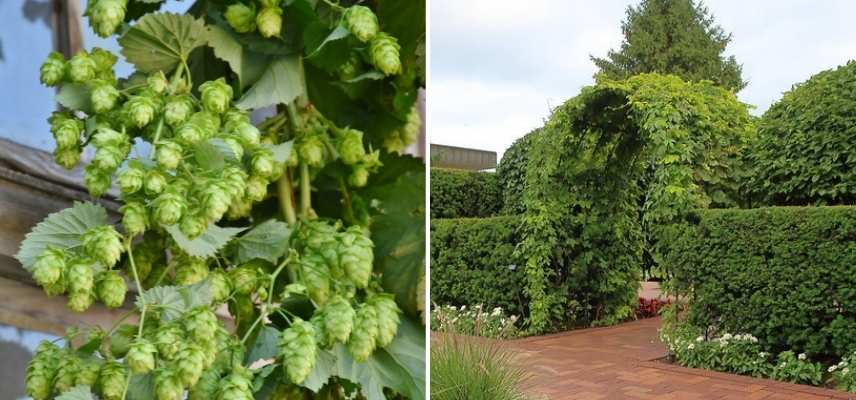
Hop, detail of female flowers and foliage, and to the right a lovely leafy arch (© Cultivar 413)
→ Learn more about hop in our guide Hop, planting, growing, and uses
Ipomoea learii: giant and floriferous
Ipomoea is one of those stunning annuals that grow the fastest in a single season. The genus Ipomoea includes around 500 species of climbing or bushy plants, native to South America or the Indian subcontinent. Ipomea learii, also commonly known as Indian Ipomoea, Ipomea acuminata, or Ipomea indica, is You should plant this beautiful ipomoea in full sun to see its flowers open sufficiently, which bloom in the morning. It does wonderfully by wrapping itself around a trellis, a pergola, or with a little help along a fence, and even up a large tree. You can also grow it in a large pot on a balcony or terrace. It brings an almost exotic air to the garden due to the colour and exuberance of its flowers and foliage.
⇒ The secret to achieving maximum growth? : provide your Ipomea learii with well-drained, yet rich soil.
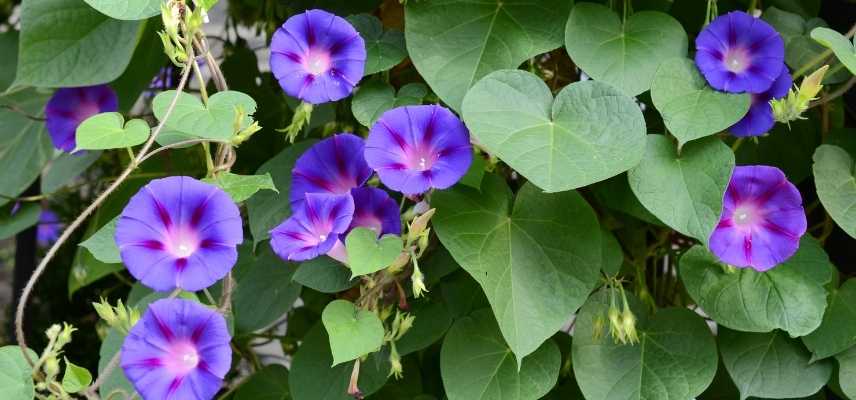
Ipomea learii
→ Learn more about Ipomoeas in our comprehensive guide on Ipomoeas
Discover other Climbers
View all →Available in 0 sizes
Available in 0 sizes
Available in 0 sizes
Available in 0 sizes
Available in 0 sizes
Available in 1 sizes
Available in 1 sizes
Available in 1 sizes
Available in 0 sizes
Available in 1 sizes
Fallopia aubertii: formidable
The Chinese Knotweed, also known as Polygonum or in Latin Fallopia aubertii, is a formidable climbing plant! This term is not used lightly, as it has a staggering growth rate (up to 5 m per year) and can become invasive (be careful not to confuse it with Fallopia japonica, the non-climbing Japanese knotweed, which is considered invasive).
By controlling it through pruning (it can reach about 10 to 12 m in height when mature), it proves to be a very delicate climbing plant with a light appearance, adorned with beautiful clusters of cream-coloured flowers and stunning heart-shaped foliage. Another advantage of this climbing plant is its long flowering period, from June to September, and its nectariferous nature. Therefore, you will reserve it for a large pergola that it will completely cover, up to 10 m², and it also quickly vegetates large walls in semi-shaded or non-scorching sunny locations. Ultra hardy, this deciduous climbing plant can be planted anywhere, especially as it is not demanding in terms of soil, its light appearance fitting perfectly into natural gardens.
⇒ The secret to limit the impetuous Aubert’s knotweed?: control its prolific growth by cutting it back every two years in winter.
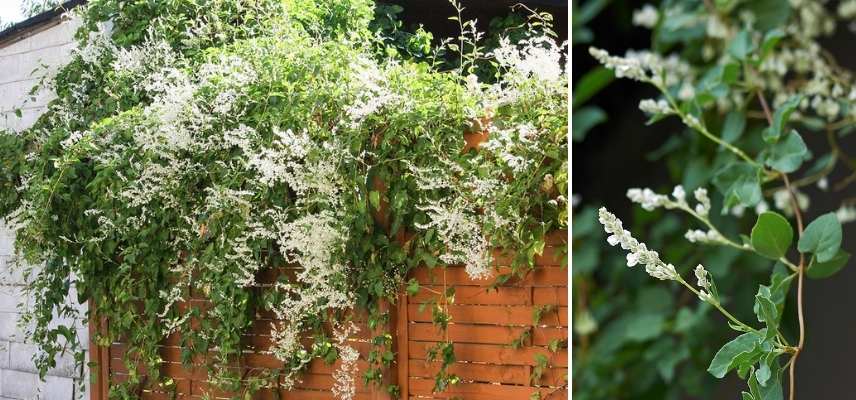
Fallopia aubertii, also known as Fallopia baldschuanica (© Maja Dumat)
Akebia quinata: delicate
In optimal growing conditions, an Akebia quinata can cover between 8 and 10 m² and grow 1 to 3 m in a single season. When mature, it can reach 6 m, sometimes 10 m depending on the varieties. This is a very beautiful climbing plant that is easy to grow, yet still too rare in our gardens. Its astonishing flowers give it a remarkable charm when they bloom in spring (between April and May), in soft shades of mauve or claret: they are grouped in pendulous clusters featuring three broad shell-shaped petals and six often contrasting stamens, emitting a vanilla fragrance. The five-leaf Akebia also has beautiful and delicate foliage that remains in place for a long time; it is semi-evergreen. This “chocolate liana” will need to be trained. It beautifully adorns an old tree trunk, a trellis, a wall, or an archway. You will just need to assist the plant by training the first young shoots, which will later wrap themselves around their support. Very hardy, it is a highly useful climber in shaded areas, often suitable for less climbing plants, knowing that it also accepts sunlight.
⇒ The secret to obtain a vigorous Akebia?: Plant it in cool, well-drained soil; to manage its exuberance, prune it in spring, after flowering.
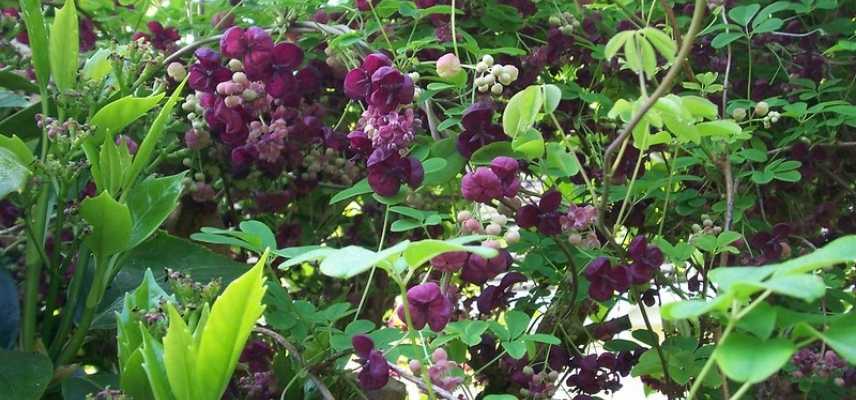
Akebia quinata (© Leonora Enking)
→ Learn more about Akebia quinata in our complete guide.
Luffa cylindrica: exotic
Not very well known to the general public, here is a climbing liana with impressive growth, reaching 3 m in a single season! Luffa cylindrica, also known as loofah gourd or sponge vine, features evergreen foliage with large, notched, slightly dentate leaves, approximately 20 cm wide. It is an ornamental liana, very vigorous like the cucurbits, the family to which it belongs, that spreads 3 to 4 m wide and reaches a final height of 3 to 6 m. Flowering occurs in summer, producing beautiful yellow flowers, as the plant requires plenty of sunlight and warmth to bloom. Luffa cylindrica thrives in rich, sandy soil. Its fruits, called pepos, are cylindrical, short, green, and hang from the plant. They are consumed young, along with the flower buds in some tropical countries, but it is primarily used as an ornamental plant in our latitudes. Its nickname, vegetable sponge, comes from the inside of the fruit, which, once dried, becomes fibrous and serves as a particularly exfoliating sponge for cleaning or as a loofah glove. In addition to its ability to grow very quickly, it is therefore an eco-friendly plant in many respects. Install the luffa on a trellis or fence, which it will cover at lightning speed, quickly decorating it with its astonishing fruits.
This vegetable sponge has Indian origins, but unfortunately, it is not very hardy and is grown as an annual here, to be sown in April.
⇒ The secret to obtain an exuberant luffa?: sunlight, warmth, soil moisture, and appropriate fertilisation!
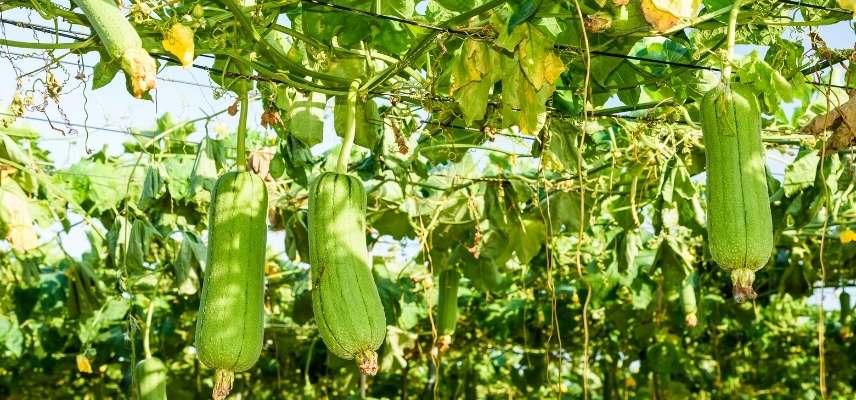
Luffa cylindrica
Holboellia: graceful
Related to Akebia, Holboellia remains relatively unknown for now, but it truly deserves recognition, especially for its ability to quickly beautify partially shaded areas. This particularly vigorous liana reaches heights of between 6 m and 10 m depending on the species. Among its many qualities, its evergreen leaflet foliage makes it ideal for use as a privacy screen on large trellises, or for permanently covering walls, arbors, or pergolas, especially since its lianas naturally wrap around supports. It blooms early in spring, between March and May, producing graceful flowers often shaped like stars and bells, ranging from cream to purple (white in H. brachyandra, purple in H. grandiflora, and bicoloured in H. angustifolia). It is a fairly hardy climbing plant that can thrive in many gardens, provided the soil is sufficiently cool, deep, well-drained, and rich in humus (with a preference for slightly acidic soils). Finally, it requires little to no maintenance.
Stauntonia hexaphylla, from the same family and often associated with Holboellias, is quite similar.
⇒ The secret to achieve maximum growth?: a shaded to partially shaded exposure is necessary, along with soil that does not dry out in summer.
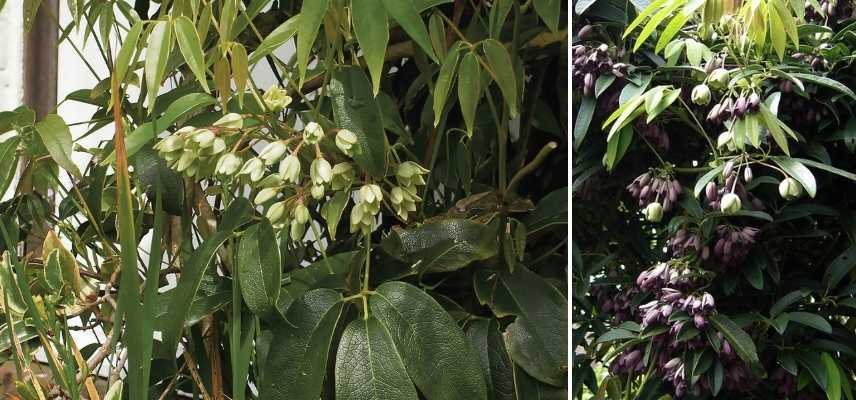
Holboellia coriacea and Holboellia angustifolia (© Peganum)
→ Learn more about Holboellia in our guide Holboellia: planting, growing and care
Hedera helix 'Hibernica': useful!
The Irish ivy is a vigorous evergreen climbing plant: it can produce stems over 1 m in a single year and will eventually spread to about 5 m. When mature, it can climb up to 10 m high, making it suitable for the walls or porches of large houses, for example. It is also very useful for greening a large, hard-to-maintain bank or for running under trees in dry soil where grass will not grow. Its dark green, glossy foliage is finely veined with white, giving it a lovely elegance. Like all ivies, it is extremely hardy, melliferous, can be planted in all exposures, and requires humus-bearing soil. The Irish ivy is particularly resistant to sun and drought conditions. With its adhesive roots, it will easily cling to its support. It is one of the plants that offers the last nectar of the year to bees!
⇒ The secret to showcase Irish ivy?: as groundcover, it becomes the king of difficult areas where nothing else will grow. We now know that ivy is not a bane to trees, so feel free to adorn the trunk of certain deciduous varieties; its winter fruits are very attractive and can be used in your festive bouquets!
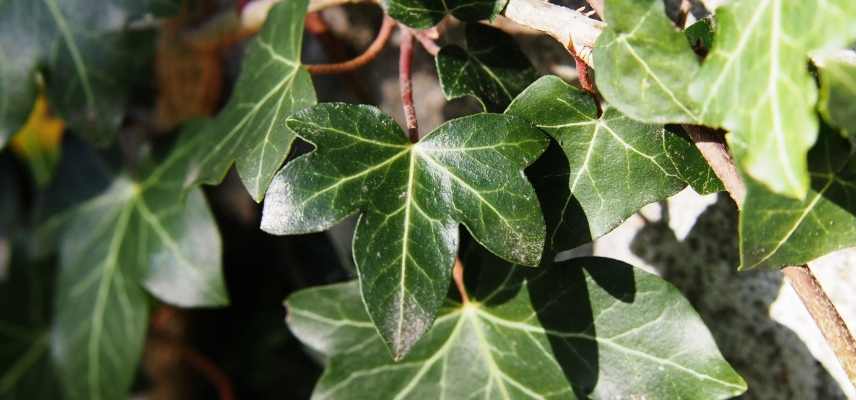
Hedera helix ‘Hibernica’
→ Learn more about ivy in our article on the Climbing Ivy
- Subscribe!
- Contents
































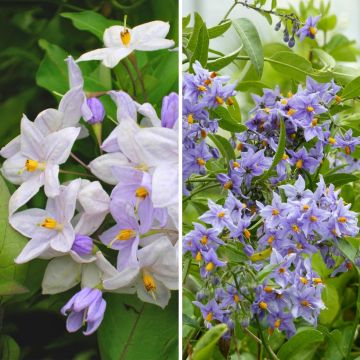
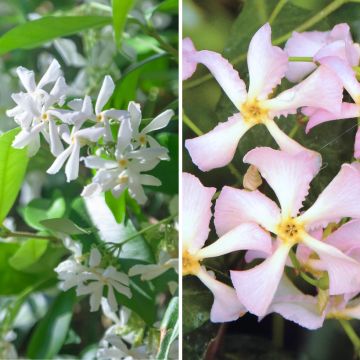

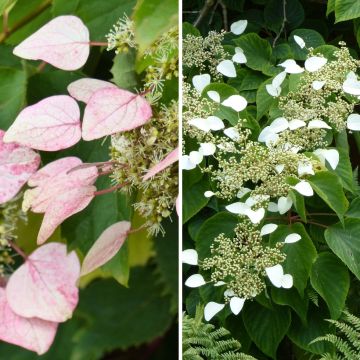
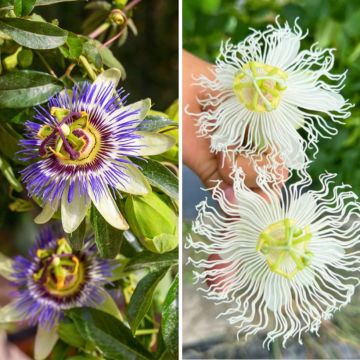

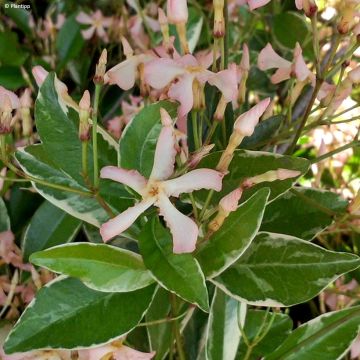
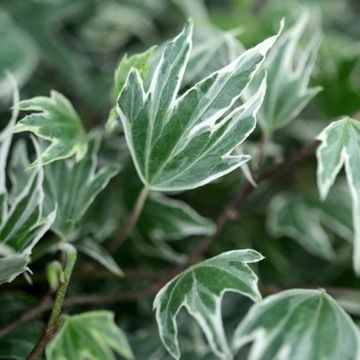
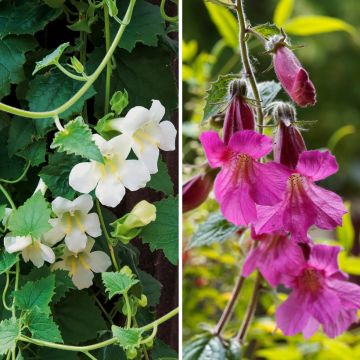
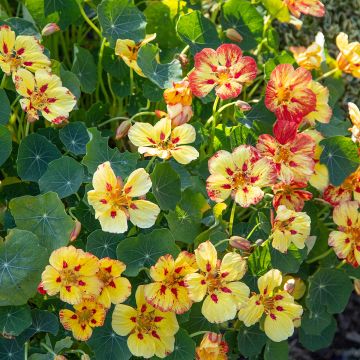
Comments